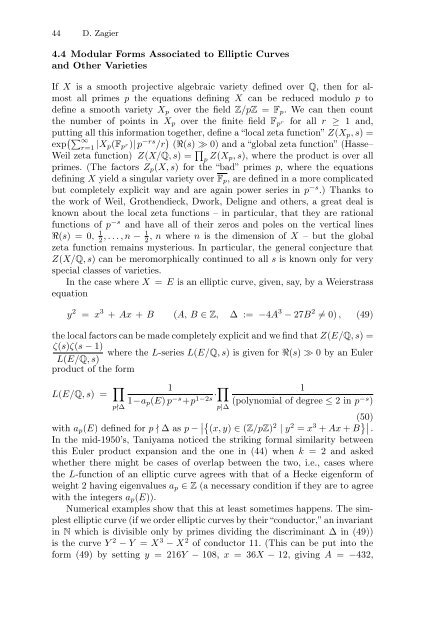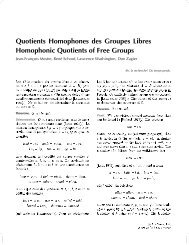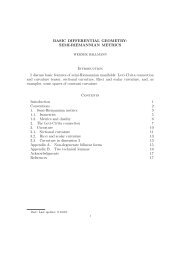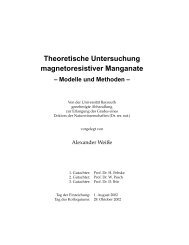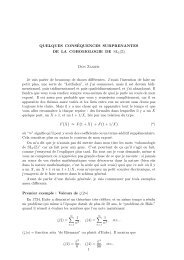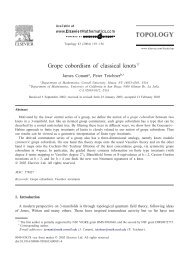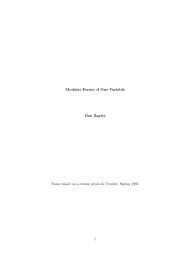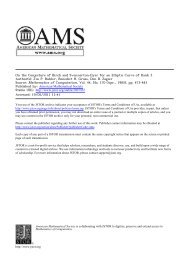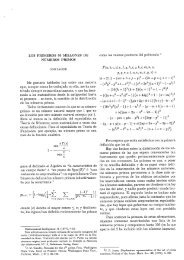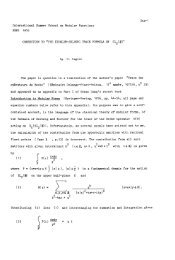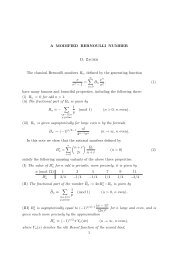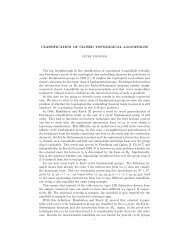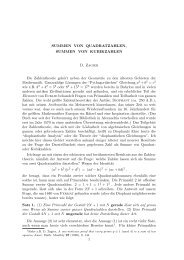Elliptic Modular Forms and Their Applications - Up To
Elliptic Modular Forms and Their Applications - Up To
Elliptic Modular Forms and Their Applications - Up To
You also want an ePaper? Increase the reach of your titles
YUMPU automatically turns print PDFs into web optimized ePapers that Google loves.
44 D. Zagier4.4 <strong>Modular</strong> <strong>Forms</strong> Associated to <strong>Elliptic</strong> Curves<strong>and</strong> Other VarietiesIf X is a smooth projective algebraic variety defined over Q, then for almostall primes p the equations defining X can be reduced modulo p todefine a smooth variety X p over the field Z/pZ = F p . We can then countthe number of points in X p over the finite field F p r for all r ≥ 1 <strong>and</strong>,putting all this information together, define a “local zeta function” Z(X p ,s)=exp (∑ ∞r=1 |X p(F p r)| p −rs /r ) (R(s) ≫ 0) <strong>and</strong> a “global zeta function” (Hasse–Weil zeta function) Z(X/Q,s)= ∏ p Z(X p,s), where the product is over allprimes. (The factors Z p (X, s) for the “bad” primes p, where the equationsdefining X yield a singular variety over F p , are defined in a more complicatedbut completely explicit way <strong>and</strong> are again power series in p −s .) Thanks tothe work of Weil, Grothendieck, Dwork, Deligne <strong>and</strong> others, a great deal isknown about the local zeta functions – in particular, that they are rationalfunctions of p −s <strong>and</strong> have all of their zeros <strong>and</strong> poles on the vertical linesR(s) =0, 1 2 ,...,n− 1 2,nwhere n is the dimension of X – but the globalzeta function remains mysterious. In particular, the general conjecture thatZ(X/Q,s) can be meromorphically continued to all s is known only for veryspecial classes of varieties.In the case where X = E is an elliptic curve, given, say, by a Weierstrassequationy 2 = x 3 + Ax + B (A, B ∈ Z, Δ := −4A 3 − 27B 2 ≠0), (49)the local factors can be made completely explicit <strong>and</strong> we find that Z(E/Q,s)=ζ(s)ζ(s − 1)where the L-series L(E/Q,s) is given for R(s) ≫ 0 by an EulerL(E/Q,s)product of the form1 ·∏1−a p (E) p −s +p1−2s p|Δ1(polynomial of degree ≤ 2 in p −s )L(E/Q,s) = ∏ p∤Δ(50)with a p (E) defined for p ∤ Δ as p − ∣ { (x, y) ∈ (Z/pZ) 2 | y 2 = x 3 + Ax + B }∣ ∣ .In the mid-1950’s, Taniyama noticed the striking formal similarity betweenthis Euler product expansion <strong>and</strong> the one in (44) when k = 2 <strong>and</strong> askedwhether there might be cases of overlap between the two, i.e., cases wherethe L-function of an elliptic curve agrees with that of a Hecke eigenform ofweight 2 having eigenvalues a p ∈ Z (a necessary condition if they are to agreewith the integers a p (E)).Numerical examples show that this at least sometimes happens. The simplestelliptic curve (if we order elliptic curves by their “conductor,” an invariantin N which is divisible only by primes dividing the discriminant Δ in (49))is the curve Y 2 − Y = X 3 − X 2 of conductor 11. (This can be put into theform (49) by setting y = 216Y − 108, x = 36X − 12, giving A = −432,


